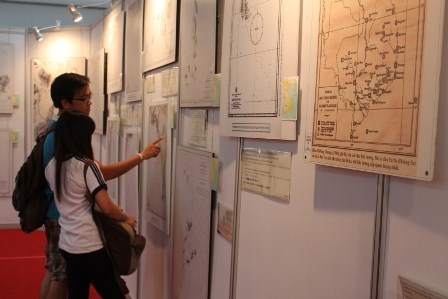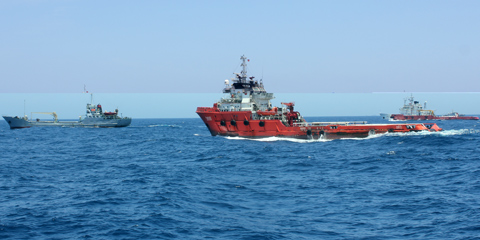|
Five
scenarios for East Sea
There are five scenarios for the

Visitors at an exhibition of
ancient maps showing Hoang Sa, Truong Sa as
Before international law, historical evidence with
legal values is the most convincing factor.
However, international law experts also said that in
resolving territorial disputes, on land or on sea, the ability of the
involving parties to have historical evidence with legal value is not high.
According to Nuno Sergio Marques Antunes, a Portuguese
expert on international maritime disputes, "the disputes based only on
legal arguments ... are relatively rare. The vast majority of the territorial
disputes lack meaningful legal arguments. In most cases, the arguments
without legal value stand out."
Each side in the territorial dispute must take
advantage of all the evidence seriously, regardless of form, as Brian Taylor
Sumner, American expert on international law has confirmed, pointing out nine
different categories, including historical evidence.
While some Western scholars relied on a part or the
entire Chinese ancient history to support
In his book published in English in 2013, Wu Shicun
used the following arguments to justify China’s claim on the islands in the
East Sea: China discovered and named the islands of the Hoang Sa-Truong Sa
Islands, China received tributes from the Vietnamese feudal government, the
Democratic Republic of Vietnam acknowledged the sovereignty of China over
Hoang Sa-Truong Sa, the Socialist Republic of Vietnam just inherited only
from the DRV, etc.
The value of the argument
Firstly, if you think
At the same time, the argument that as the country
receiving tribute from the
The argument that the Democratic Republic of Vietnam
once recognized China’s sovereignty over Hoang Sa-Truong Sa and the SRV only
inherited from the DRV, so China holds sovereignty over Hoang Sa-Truong Sa,
is rejected, based on the adaptation of the principles of prevention
(estoppel), the nation's inheritance rights under international law and
historical evidence in international relations of Vietnam in the period
1954-1976.
In addition to satisfying two standards of
international law before the Convention of Berlin, historical evidence about
Vietnam’s sovereignty over Hoang Sa in ancient Western documents in over 200
years from the early seventeenth century to the late nineteenth century
particularly satisfy criteria set forth in the 1885 Convention on the
awareness of the international community to the sovereignty of Vietnam.
In contrast, until today, the Chinese cannot present
any historical evidence favorable to their claims from the ancient Western sources
before the twentieth century.
However,
Compared with
The five scenarios
In late September 1975, in a meeting between leaders of
the two countries, when the First Secretary of the Workers' Party of Vietnam
Le Duan raised the issues of Hoang Sa-Truong Sa Islands, Chinese Vice Premier
Deng Xiaoping admitted the dispute and proposed that the two countries
discuss the issue later. But, after nearly 40 years, the dispute has not been
resolved.
In this context, we believe that there are five
scenarios for the
The first scenario, China will use force to invade a
part or entire Truong Sa Islands, in order to "resolve disputes and
establish sovereignty over the islands and territorial waters by 2020"
as Chinese scholars asserted and according to other sources.
In the marine disputes,
The new military adventure of
No one was surprised with the statement that
However, due to major differences with the annexation
of the Crimea to

The second scenario,
The third scenario,
Based on the principles set forth in international law,
The fact shows that
The fourth scenario,
This scenario helps
This scenario is disadvantageous for
The fifth scenario.
The events related to the
Thai Van Cau,
(The author is a space scientist of Vietnamese origin living in the |
Thứ Năm, 31 tháng 7, 2014
Đăng ký:
Đăng Nhận xét (Atom)
Không có nhận xét nào:
Đăng nhận xét